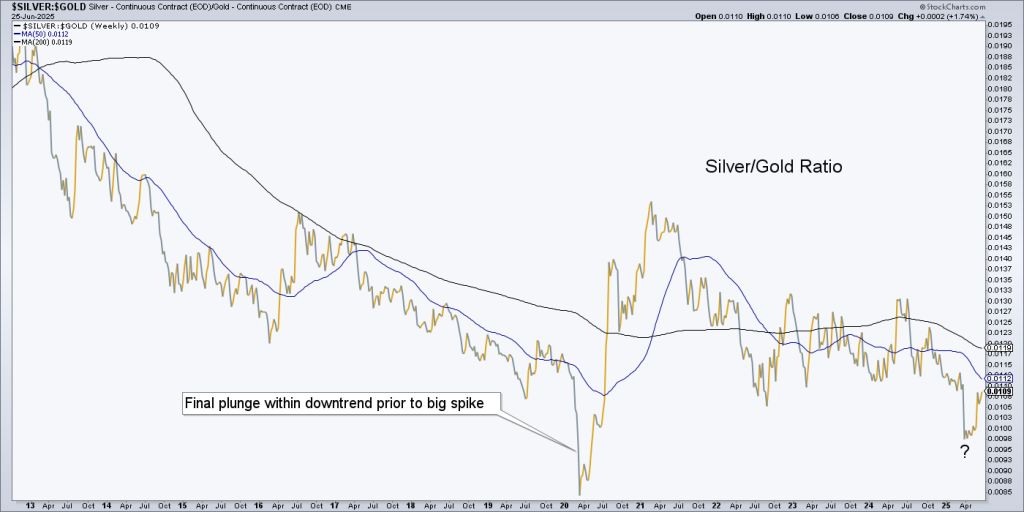In an era marked by significant shifts in economic landscapes and investment strategies, the concept of the Silver/Gold Ratio (SGR) trades, as I designate them, emerges as a pivotal indicator of an impending upsurge in the broader commodities market. Historically relegated to the background as mere “inflation trades”, this perspective takes on new salience in the aftermath of 2021, a period characterised by pronounced inflationary pressures that consequentially led to a general downtrend in commodity values, primarily due to the hawkish stance of the Federal Reserve which bolstered the US dollar’s strength.
This recalibrated approach to understanding the dynamics of commodity markets posits the Silver/Gold ratio as a bellwether for cyclical market phases, particularly under the influence of inflation-driven policy measures. The premise is straightforward yet insightful: when silver outpaces gold, it signals a healthy cyclical market remains in operation, notwithstanding external pressures.
Recently, amid mixed cues from the bond markets and indicators of a decelerating global economy, silver appeared primed to assume the mantle of market leadership from gold. This was a development I began to monitor more closely, as evidenced in “NFTRH 858 (April 13th)”, where an in-depth analysis of the SGR revealed potential undercurrents of change. Despite the lack of a robust technical foundation for a bullish silver outlook, historical patterns suggest that significant directional swings—such as the sharp decline observed—are often precursors to equally forceful counter-movements.
The divergent fortunes of the SGR, as noted in the aforementioned analysis, underscore a scenario driven by event-specific influences, similar yet distinct from the 2020 market upheaval. In this light, a temporary ascendancy of silver could be envisaged as a tactical trading opportunity rather than indicative of a long-term trend. This is particularly pertinent considering the prevailing macroeconomic projections anticipating a liquidity crunch and possible deflationary spiral, which could, in turn, trigger a dovish pivot in central banks’ policy directions.
Such contemplations, while speculative, provide fertile ground for strategic investments, particularly in the realms of precious metals like silver. My own venture into physical silver trading, as detailed in the update, was propelled by these broader market analyses, distinguishing between the potential for short-term gains and the possibility of a more enduring structural shift in the market should central banks and governments intensify efforts to stoke inflation.
The journey of the SGR, as depicted in recent charts, suggests an ongoing downtrend, yet imbued with the potential for an upswing, as hinted at in pre-market movements. This narrative, however, unfolds within the complex tapestry of global financial markets, where factors such as the U.S. dollar’s performance, geopolitical tensions, and the volatile nature of energy commodities like oil, play influential roles.
Interestingly, the broader market’s tepid response to these analyses might reflect the entrenched skepticism or misalignment with prevailing economic doctrines that emphasize direct correlations between conflict-induced oil price spikes and inflation. Yet, strategic foresight, as illustrated by timely trades in response to these dynamics, underscores the importance of nuanced market understanding over simplistic causality chains.
Looking ahead, the prospect of a sustained rally in oil, driven by foundational support levels, aligns with a broader spectrum of commodities poised for recovery. From industrial metals to exotic elements like Rare Earth Materials and Platinum Group Metals, diverse sectors anticipate rejuvenation, contingent upon the SGR’s trajectory.
Summarily, while the immediate outlook for silver, and by extension the broader commodities market, presents a tactical trading window, the overarching narrative remains cautionary. The potential for abrupt market reversals, prompted by systemic liquidations, looms large, suggesting the current rally could culminate in dramatic retrenchment.
Yet, in this complex mosaic of economic indicators, market sentiment, and geopolitical flux, the role of informed analysis remains paramount. The journey through these turbulent waters, punctuated by moments of clarity and confusion alike, echoes the broader quest for understanding in an ever-evolving financial landscape. It’s a reminder that in the world of investing, as in life, foresight, adaptability, and an adherence to sound principles stand as our most reliable guides.



